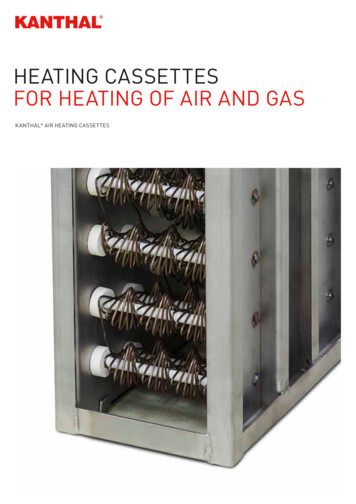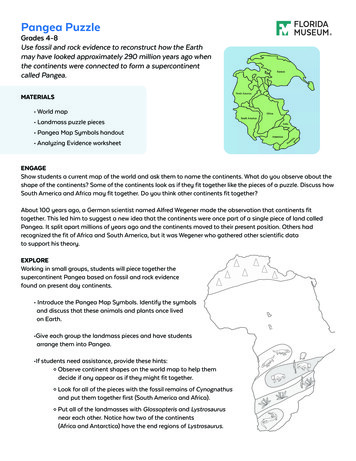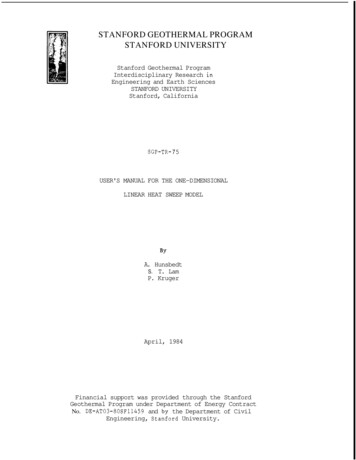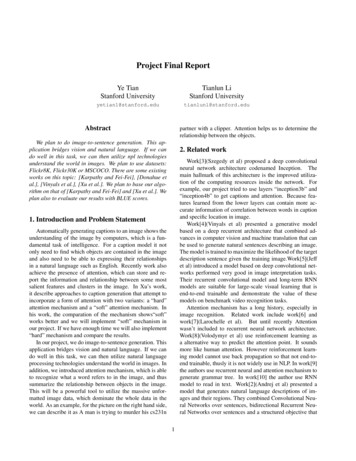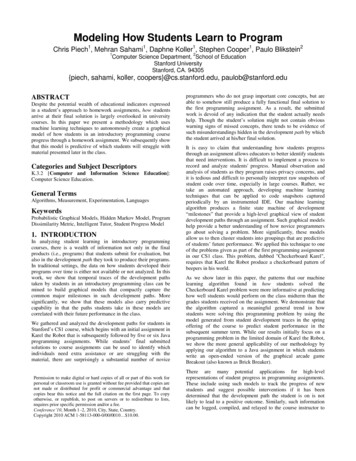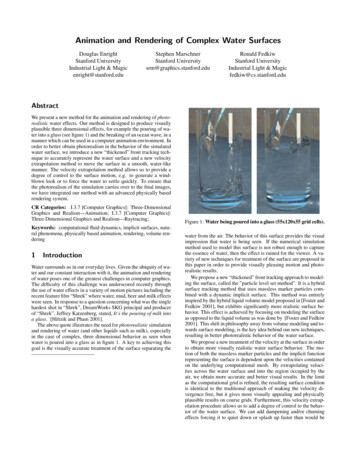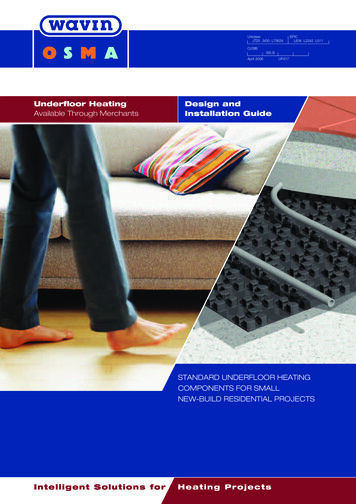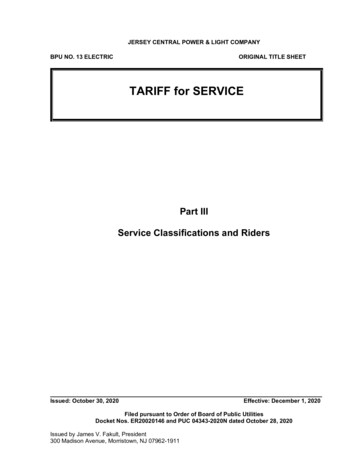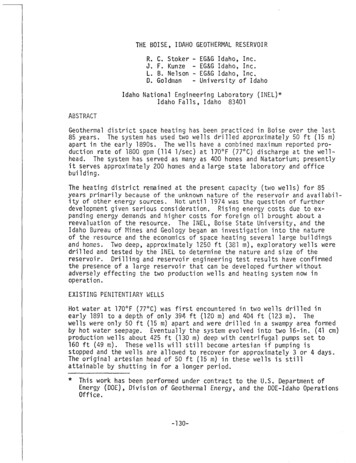
Transcription
THE BOISE, IDAHO GEOTHERMAL RESERVOIRR. C. StokerJ. F. KunzeL. B. NelsonD. Goldman-EG&G Idaho, Inc.EG&G Idaho, Inc.EG&G Idaho, Inc.University of IdahoIdaho National Engineering Laboratory (INEL)"Idaho F a l l s , Idaho 83401ABS T Rk CTGeothermal d i s t r i c t space heating has been practiced i n Boise over the l a s t85 years. The system has used two wells d r i l l e d approximately 50 f t (15 m )a p a r t i n the e a r l y 1890s. The wells have a combined maximum reported production r a t e of 1800 gpm (114 l / s e c ) a t 170 F (77 C) discharge a t the wellhead. The system has served as many as 400 homes and Natatorium; presentlyi t serves approximately 200 homes and a large state laboratory and o f f i c ebui 1d i n g .The h e a t i n g d i s t r i c t remained a t the present capacity (two w e l l s ) f o r 85years primarily because of the unknown nature o f the r e s e r v o i r and a v a i l a b i l i t y of o t h e r energy sources. Not u n t i l 1974 was the question o f f u r t h e rdevelopment given serious consideration, Rising energy c o s t s due t o exp a n d i n g energy demands and higher c o s t s f o r foreign o i l b r o u g h t about areevaluation of the resource. The INEL, Boise S t a t e University, and theIdaho Bureau of Mines and Geology began an investigation i n t o the natureof the resource and the economics of space heating several l a r g e buildingsand homes. Two deep, approximately 1250 f t (381 m ) , exploratory wells wered r i l l e d and t e s t e d by the INEL t o determine the nature and s i z e of thereservoir. D r i l l i n g and r e s e r v o i r engineering t e s t r e s u l t s have confirinedthe presence o f a large r e s e r v o i r t h a t can be developed f u r t h e r withoutadversely e f f e c t i n g the two production wells and heating system now i noperati on.EXISTING PENITENTIARY WELLSHot water a t 170 F (77 C) was f i r s t encountered i n two wells d r i l l e d i ne a r l y 1891 t o a depth of only 394 f t (120 m ) and 404 f t (123 m ) . Thewells were only 50 f t (15 m) a p a r t and were d r i l l e d i n a swampy area formedby hot water seepage. Eventually the systeni evolved i n t o two 1 6 - i n . (41 cm)production wells about 425 f t (130 m ) deep w i t h centrifugal pumps s e t t o160 f t (49 m ) . These wells w i l l s t i l l beconie a r t e s i a n i f pumping i sstopped and the wells are allowed t o recover f o r approximately 3 o r 4 days.The o r i g i n a l a r t e s i a n head of 50 f t (15 m ) i n these wells i s s t i l la t t a i n a b l e by s h u t t i n g i n f o r a longer period.*This work has been performed under c o n t r a c t t o the U.S. Department ofEnergy (DOE) , Division of Geothermal Energy, and the DOE-Idaho OperationsOffice.-1 30-
During the l a s t y e a r , these old production wells have been monitored f o rwater level drawdown. During l a t e January, 1977, the drawdown reached amaximum of 143 f t (44 m) below ground level ( j u s t above the pump bowls).High flow r a t e s ( u p t o 1600 gpm from both w e l l s ) caused by unusually coldweather and system leakage accounted f o r t h i s extreme drawdown.TWO EXPLORATORY WELLSIn the winter and e a r l y spring of 1976, the I N E L d r i l l e d two exploratorywells 1000 f t (305 rn) a p a r t and approximately 1-1/2 m i (2.4 km) northwestof the penitentiary ;.iells. Each of the exploratory wells were d r i l l e dw i t h i n the immediate area of the main NW-SE trending Boise Front Fault andi n t e r s e c t i n g l i n e a r s trending from the NE out of the mountains. The welllocations are i d e n t i f i e d on Figure 1 . The BEH-1 (BLM) well was d r i l l e d t oa t o t a l depth of 1222 f t (372 m ) , has 7 - i n . (18 cm) production casing s e tt o 610 f t (186 m ) and a s l o t t e d 3-1/2 i n . (9 cin) l i n e r h u n g from theproduction casing t o t o t a l depth. See Figure 2 .The BHW-1 (Beard)has 8-in. (20 cn)4-1/2 i n . (11 cm)duction casing t owell was d r i l l e d t o a t o t a l depth of 1283 f t (391 m ) ,production casing s e t t o 202 f t (62 m ) and a s l o t t e dl i n e r w i t h 100 f t (30 m) o f screen h u n g from the prot o t a l depth. See Figure 3.The BEH-1 (BLM) well was d r i l l e d w i t h water out of the production casingb u t encountered clay lenses (Nontmori 1 loni t e ) d u r i n g d r i 11 i n g whichnecessitated cl eanom of the p i t s three d i f f e r e n t t i n e s . BHW-1 (Beard)well was d r i l l e d witn l i g h t mud i n an attempt t o s t a b i l i z e the looselycemented sand beds encountered between 450 and 800 f t (137 and 245 m ) .EXPLORATORY WELL TESTINGReservoir engineering t e s t i n g of the two exploratory wells has been asfol1 ows :1.Temperature p r o f i l e s o f the wells were taken d u r i n g d r i l l i n g anda f t e r the well had s t a b i l i z e d . See Figure 4 f o r the temperaturep r o f i l e of BHW-1 (Beard). The p r o f i l e on BEH-1 (BLM) i s e s s e n t i a l l yi denti cal .2.Artesian wellhead pressure was monitored a l l d u r i n g the 1976-77heating season a t BEH-1 (BLM). No c o r r e l a t a b l e pressure communicat i o n was observed as a r e s u l t of the pumping conducted a t the oldpenitentiary wells. A seasonal pressure decline of 2-1/2 psia wasobserved d u r i n g the winter,but recovery began w i t h the spring run o f f .3.Artesian and pumped flow t e s t s on each o f the exploratory wellswas conducted. A s h a f t driven pump s e t a t approximately 185 f t(56 m) was employed f o r the pumped flow t e s t s , Table I summarizesthe Boise t e s t i n g completed t o date.-1 31-
4.Interference testing revealed a r a p i d pressure communication between'the two wells; 0.1 psia change within two minutes of the s t a r t o f a t e s t .The BEH-1 well production (artesian flow) will be used f o r space heatingof a BLM warehouse t h i s winter and the long term drawdown will bemoni t o red.CONCLUSIONSThe 170" F geothermal reservoir boundaries have n o t been detected a n dthe reservoir appears t o be capable of usage rates f a r exceeding thepresent rate.The reservoir i s proven t o extend a t l e a s t 1-1/2 miles along the Fault.Similar geologic conditions occur in several locations along theBoise Front Fault t h a t apparently control the geothermal resourceas now defined by the existing four wells.Test results indicate that future production wells (properly located)will have high production rates i n the order of 600 t o 1000 gpm f o r12 to 16 i n . (30 t o 40 cm) wells a t pump s e t t i n g depths of 400 f e e t .The geothermal resource can be encountered a t relatively shallowdepths ( l o 0 0 f t or 305 m ) and a t temperatures (170 F or 77 C)adequate f o r large scale space heating. The wells should belocated close t o the' intersection o f NE trending linears with theFront Fault for the greatest possible production rates and highesttemperatures close t o the service areas.The authors wish t o t h a n k the geology students, faculty a nd especiallyRenald N. Guillemette of Boise State University f o r t h e i r assistaiice andhelp d u r i n g the Boise Project.-1 32-
WELL LOCATIONS IN B O I S E IDAHO12Stat? Veteran s HomeLer, B Jordan Olflce4 Idaha S u p r e m e Cotirt5 Idah,? Slalc Library6 New State Office- School of Business8 Library9 Liberal Arts1 @ S t u d e n t Unlon1 1 Julia Davis Palh12 Ann Morrison Parh13 Revetment Ared14 Mor f1ings ide He19ht s S(r bd IVI s I0n15 Old Gravel Pit3Figure 1-1 33-
BEH-IElev 2740100'DatumSandstone very fine grain clearsub-angular unconsolidated ironstain trace Rose Ouartz-.-200-300-400-7 0 D CasingSet @ I 610Cla! blue gray sandy-siltyPyrl!e. Selenite. trace ObsedianSandstone clear-smokey mediumcourse grain abundant PyriteRhyolite. Basalt-Scoria Gypsum10 5 8" HGle-4500-BEH-t (ELM1Well and Lithology Cross SectionLegendBasaltSandstonc. Oiiartz. G:,art:jteSiltstor eClayClay altered BasaltPyriteMicaGypsum SeleniteIron StainCore 1007-12 --5' Received N g h l yFractured and Altere9 ConglomerateContains Montmorillonite an2 Kaolinite(x-ray analysis)Slotted CasingPlain Casing --CementedLocatior:600-700'-Packer (18 overlap1Basalt black-broun some mottledsome porphyritic s3me alteredsoft Pyrite nuggets large loosegrains. some Gypsum trace QuartzGrains781'800' -,--1054'Plain Casing (typ )Sec 1 1 T 3 h R2EINEL-A-604221' of slotted casing1222"TD 1222'Figure 2-1 34-
I--.,LO.---.-a*a!-1II-,002 ICPO9-V-13 NI- .OOL- ,009- .ms- .oorOf L 2 'Aal31-MHB
0BHW-1Boise. Idaho7 D on 7-22-76 ( 1283 1 1 0130050601I1708090IIII1IIIII 1100 110 120 130 140 150 160 170 180 190 200-Figure 4-1 36-
UI-v,WIWv,U0mu aCzTCs az:%c,aSC*I-r[: 5Ew 5c,crdan c cEC0aWcntuc0O Lv-c,om NIxcn7N.nnu uY Ynfl.ccc’aJntu0 0ww(vh-Iv,x0IDv-Lnm0Lnc0c-x(Dex x0NWexLn0hcxm7xL n Y-aLluW-0LmUUmluWmWmL0Nr:-Jm-1 37-ax0cdULrdWmrdc,rdUtueat-rdLc,aNhv
THE BOISE, IDAHO GEOTHERMAL RESERVOIR R. C. Stoker - EG&G Idaho, Inc. J. F. Kunze - EG&G Idaho, Inc. L. B. Nelson - EG&G Idaho, Inc. D. Goldman - University of Idaho Idaho National Engineering Laboratory (INEL)" Idaho Falls, Idaho 83401 ABS T Rk CT Geothermal district space heating has been practiced in Boise over the last 85 years.
